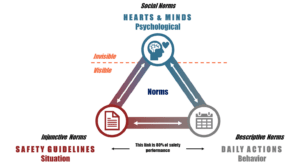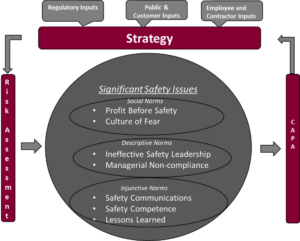A good safety culture is made up of several norms, but when was the last time you checked up on them? Dom Cooper says the time is now.
Research and experience show how an organisation’s culture of safety (safety culture being the short-hand term) can impact safety outcomes. Those possessing a strong and effective culture of safety, tend to have less frequent, and less severe, adverse incidents. Many entities have well-established and proven safety management systems, documented procedures, and qualified safety resources in place, but still experience devastating incidents. Numerous public enquiries into major safety catastrophes have identified a positive ‘culture of safety’ as the missing link.

Reciprocal safety culture model
When pondering what a culture of safety might look like, research[i] has identified that it is comprised of three major interactive components that coincide with those found in accident causation models. These are: psychological, behavioural, and situational. Studies[ii] show the reciprocal behavioural-situational link is the most influential in affecting actual safety performance. The psychological component serves to create the commitment necessary for a group of people to overcome safety problems by creating appropriate behavioural norms, safety processes and systems[iii].
All three play particular roles: Hearts and Minds are reflected in an organisation’s “invisible” social norms or expectations[iv] (i.e., our beliefs of how safety should be done around here). Visible descriptive norms reflect those behavioural action patterns displayed daily by most in an organisation (i.e., how we enforce and reinforce the collective safety-related behaviours being done around here). Visible injunctive norms are reflected by the safety guidelines that direct what ought to be done to control risk when stakeholders, facilities or equipment are presented with threats and/or hazards. The more these reciprocal norms are in alignment to proactively prioritise “safe-production”, the greater the effectiveness of an entity’s culture of safety.
Important operational features of a culture of safety
Within these three major cultural components, academic research, public inquiries into catastrophes, and loss of containment studies have identified a common set of seven important features that require significant attention to prevent adverse events.
Social Norms
Profit before safety relates to productivity coming before safety, when safety is viewed as a cost, not an investment. Ideally, entities would adopt the philosophy that ‘safe-production’ is the number one priority, and configure all their processes, resources, and actions around that[v].
A culture of fear refers to serious problems remaining hidden and being driven underground by those trying to avoid sanctions or reprimands from their leaders and coworkers. Undocumented workers may be particularly prone to a culture of fear arising from a blame culture.
Descriptive Norms
Ineffective safety leadership refers to blinkered leadership and the prevailing corporate culture preventing the recognition of risks and opportunities. In turn, this leads to wrong safety decisions being made at the wrong time, for the wrong reasons. This often stems from leader’s lack of knowledge about their safety responsibilities and associated accountabilities; their freedom to act to address safety issues; and a lack of knowledge about pertinent aspects of the safety management system that apply to their sphere of influence[vi].
Managerial non-compliance refers to a lack of managerial compliance to standards, rules, and procedures[vii], which have led to everyday routine operations and maintenance triggering around eighty percent of the world’s process safety disasters. This indicates that cultural improvement initiatives should primarily focus on management and their compliance to rules, procedures, and standards; although it is recognised there can also be non-compliance amongst the workforce and contractors.
Injunctive Norms
Safety Communications are key, and primarily concerned with preventing problems of ‘miscommunication’; where critical safety information is not being relayed to decision-makers and/or the message has been diluted as it reaches its targeted recipients. Poor communication has been shown to be a major contributor in many workplace fatality incidents[viii]. The principle for addressing such issues is to recognise that “a communication not received, is not a communication at all”. This means organisations need to concern themselves with the challenge of ensuring there are sufficient two-way communication and feedback channels to ensure any message is received, understood, and acted upon.
Safety Competence is defined as “the ability of an individual or organisation to do a job properly”. Competency failures are highlighted in many inquiries into safety catastrophes where there were false expectations that direct hires and contractors were highly trained and competent. Competence is multidimensional and includes [a] Cognitive Competence: the ability to learn facts and principles; [b] Functional Competence: the ability to make decisions, plan work, do the work, and solve problems; and [c] Enabling Competence: the ability to lead, communicate, interact with others, and work in a team. Competent people are highly educated in their domains (e.g., Aviation, Construction), understand any background theory, possess practical experience of applying that theory in a wide range of situations, and can problem solve and articulate any requirements to others[ix].
‘Lessons learned’ refers to situations where critical safety information is extracted from near-misses and/or adverse events; where it is shared in a timely manner; and is applied and enforced. To be termed a lesson, it must be [a] an issue that had a significant impact on everyday operations; [b] valid (i.e., factually and technically correct); [c] applicable in that it identified a specific process, decision, or failure; and [d] must resolve the issue[x]. To be termed a lesson learned, there must be an observable and measurable positive change in the behaviour(s) associated with the lesson that improves performance in some predefined way.
To use it is to make it useful
Making use of the above, an entity would perform a risk assessment on each of these cultural topics to identify and evaluate their exposure to less-than-ideal conditions that threaten their culture of safety. Once evaluated, any issues of concern should be addressed as part of a corrective and prevention action process (CAPA). Ideally, the seven cultural features above would also form a part of an entity’s overall strategy (all entities should have one of these) to further develop and enhance their culture of safety The principle of a continual improvement cycle is shown in the figure below.
Risk assessment is the bedrock of most international safety management system standards and/or regulation. Risk refers to ‘the possibility of harm or loss’ presented by the existence of perceived threats arising from particular situations. Every aspect of operations presents their own threats, and these require formal risk assessments to ensure no harm is experienced to people or assets. Risk assessment should be considered a fundamental process to specifically identify and control any threats arising from any of the core seven cultural features outlined above.

Figure 2: Continual Improvement Cycle to enhance your culture of safety
Corrective and preventative actions (CAPA) is integral to safety culture improvement, and refers to organisational action(s) required to rectify and/or eliminate potential or actual threats. There are seven basic steps related to CAPA, which, when adapted to addressing safety culture attributes, include [1] Identifying and defining a cultural norm problem; [2] evaluating the magnitude and potential impact of that cultural norm problem; [3] identifying the root cause(s) of that problem; [4] performing and documenting a risk assessment; [5] developing an appropriate action plan that defines and delivers the appropriate risk controls; [6] executing the action plan; and [7] verifying and assessing the effectiveness of the implemented risk controls.
Strategy: Improving safety culture requires a comprehensive strategy be designed and employed to ensure that any significant changes are rolled-out in a controlled and systematic manner. Strategy refers to ‘Planning and Directing’ the entire improvement process. Strategy should provide a clear direction for all stakeholders toward an advanced culture of safety that supports lasting changes to the entity’s social and behavioural norms, and optimises every working situation or environment to support desired safety-related behaviours. In turn, this requires the use of a formal strategic safety culture planning process.
Risk assessing known cultural features appears to be a novel approach to improving a culture of safety, but it shouldn’t be. Typically, entities already try to do this via safety culture surveys trying to identify what might be going right or wrong. The real difference here is the typical OSH risk assessment process is used to evaluate actual threats and potential harm arising from an entity’s own cultural norms reflected in those seven cultural features outlined above. For example, what would you find if you risk assessed your exposure to managerial non-compliance to procedures and regulations, and/or leadership’s lack of knowledge of their safety responsibilities and accountabilities? Personally, I would not be shocked if you found numerous areas of opportunity.
Happy hunting.
References
[i] Cooper, M. D. (2000). Towards a model of safety culture. Safety science, 36(2), 111-136.
[ii] Cooper, M. D., Collins, M., Bernard, R., Schwann, S., & Knox, R. J. (2019). Criterion-related validity of the cultural web when assessing safety culture. Safety science, 111, 49-66.
[iii] Quick, J.C., (1992). Crafting an organizational culture: Herb’s hand at Southwest Airlines. Organizational Dynamics. 21 (2), 45–56.
[iv] Morris, M. W., Hong, Y. Y., Chiu, C. Y., & Liu, Z. (2015). Normology: Integrating insights about social norms to understand cultural dynamics. Organizational Behavior and Human Decision Processes, 129, 1-13.
[v] Johnston, D., Pagell, M., Veltri, A., & Klassen, R. (2020). Values-in-action that support safe production. Journal of safety research, 72, 75-91.
[vi] Chief Counsel’s Report. (2011). Macondo: The Gulf Oil Disaster. National Commission on the BP Deepwater Horizon Oil Spill and Offshore Drilling
[vii] Collins, A. & Keely, D. (2003). Loss of Containment Incident Analysis. HSL/2003/07: London.
[viii] Whittington, C., Livingston, A., & Lucas, D. A. (1992). Research into management, organizational and human factors in the construction industry. HSE Contract Research Report: No. 45/1992, HMSO.
[ix] Boyatzis, R.E (1982). The Competent Manager: A Model for Effective Performance.
[x] Roe, T.H., Hollars, L., Marinan, C., et al (2011). Establishing a Lessons learned Program. Center for Army Lessons Learned, KS USA.
CREDIT: Homepage image (wires) – JG Photography/Alamy Stock Photo
The Safety Conversation Podcast: Listen now!
The Safety Conversation with SHP (previously the Safety and Health Podcast) aims to bring you the latest news, insights and legislation updates in the form of interviews, discussions and panel debates from leading figures within the profession.
Find us on Apple Podcasts, Spotify and Google Podcasts, subscribe and join the conversation today!



